 |
|
 |
2018
March
31
|
Flexible silicone zip cord for 12-volt power cables
For some time I've been recommending
18-gauge lamp cord
for the 12-volt power cables for telescopes.
It's a bit thick and stiff, but unlike thinner cables, it can handle the 3 or 4 amps required by a modern
telescope mount (not continuously, but when slewing at high speed).
It's available at every hardware store.
Most extension cords nowadays are 16 gauge (even thicker and stiffer), but
cheaper extension cords at a dollar store may be 18-gauge, and they're fine
for 12-volt lines even if you wouldn't use them for their original purpose.
But here's something better.
Amazon is now selling
BNTECHGO 18-gauge silicone zip cord.
Don't confuse this with the much stiffer red and black zip cord that is showing up at auto parts stores,
nor with some of BNTECHGO's other products, which consist of red and black wire spooled together
but not joined. This product has the red and black wires joined, just as in lamp cord, although a bit more
care is needed zipping them apart because they may tear when that is done.
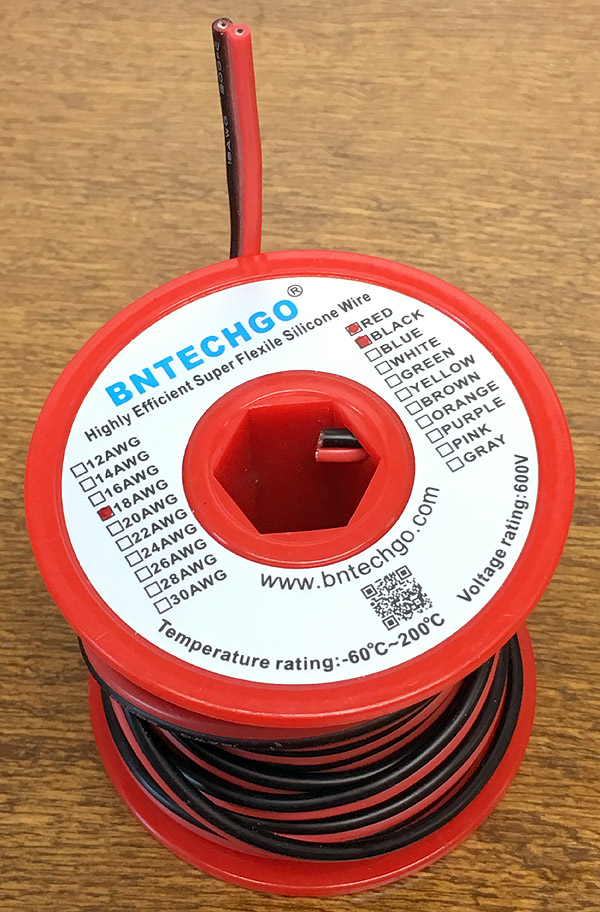
This wire is extra flexible not only because the insulation is silicone,
but also because the conductors are many strands of very fine wire, rather than
the smaller number of larger strands used in lamp cord.
Because it's heat resistant, the insulation doesn't melt when you solder near it
(hmmm, I think I'd like all my wire to be that way).
Recommended. It would also be great for speaker wire to speakers that are moved around a lot.
Permanent link to this entry
Gadgets for the handicapped, 1:
Rolling walker converted to cart
After half a dozen hip operations, Melody usually walks without a walker or cane,
but she has started using her rolling walker (rollator) as a cart to carry small objects.
(She's still a little too unsteady to carry complex loads around.)
Since she never sits on the seat, I modified it to be a better cart:

The shelf is a piece of MDF cut for me at Home Depot.
Note the screw eyes and zip ties holding it down so it can't flip over.
The two cup holders are from Pep Boys; they're supposed to sit on the dashboard of a car
and hold coffee cups or something. They are extremely handy on this cart.
Internal springs hold cups and bottles upright whether they are small or large.
The next step might be to put the shelf higher. But the low position keeps it steadier
(less jostle from changes of angle) and Melody seems to like it that way.
Permanent link to this entry
Gadgets for the handicapped, 2:
Bathroom suction-cup removal tool
Ever since her hip problems started, Melody has taken showers sitting on a seat
that attaches to the bottom of the bathtub with large suction cups.
That's fine until I want to bathe. Then I have to undo the suction cups and move
the seat out. They are hard to reach.
I made a tool for prying the suction cups up:
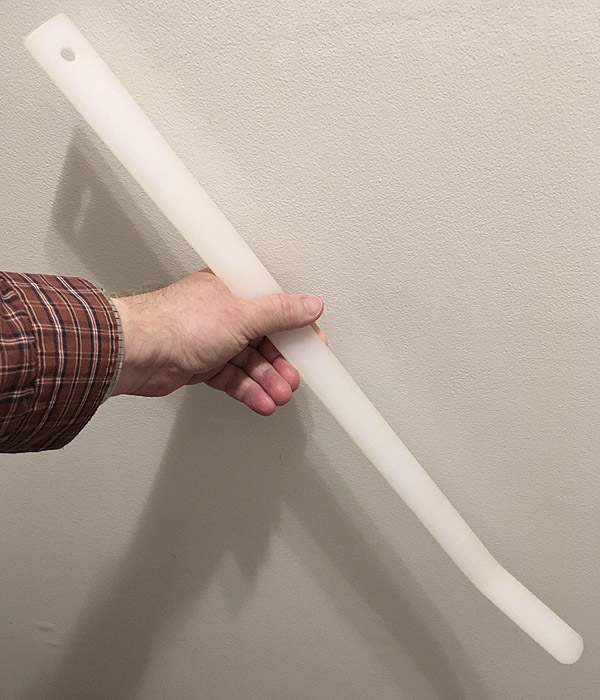


I apologize for the poor pictures; this thing is almost unphotographable, at least with
an iPhone. The image processing system is sure this bright white object
isn't something it should focus on!
I made it from a scrap of 1/4-inch acrylic (Lucite or Plexiglass).
I used a heat gun to warm it up in one place and bend it.
Then I rounded and sharpened the end with sandpaper.
I wish someone would manufacture this. Any takers?
Permanent link to this entry 

|
2018
March
30
|
How to fix a TimerCap
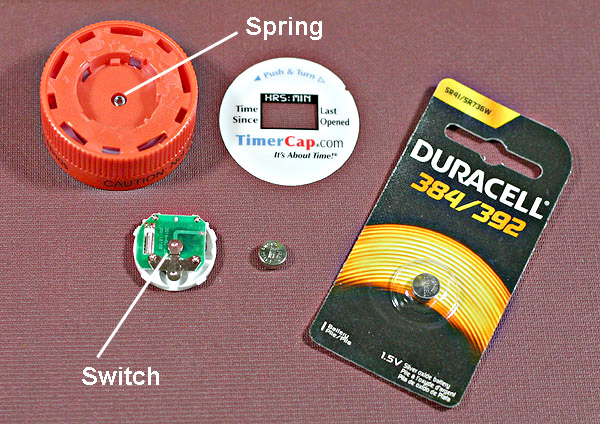
A while back I wrote about how to replace
batteries in TimerCaps, which are caps for pill bottles that have timers built
into them. They reset to zero when you open the bottle and then tell you how much
time has elapsed since you put the cap back on.
I am glad to report that besides being sold by
TimerCap.com, TimerCaps are turning up
in local pharmacies. They are very handy.
Today I want to say a few more things about troubleshooting and repairing TimerCaps.
Symptom: Cap does not fit on bottle.
There's more than one kind of TimerCap.
Make sure you've gotten the right kind for the bottles your pharmacy uses.
Check whether the bottle has five tabs or six, whether the tabs are wide or
narrow, and so forth.
Symptom: Cap comes off the bottle easily.
It could be the wrong kind, but note that the orange-rimmed non-child-resistant
TimerCaps are supposed to come off easily, even though they attach to the bottle the
same way a child-resistant cap does.
Symptom: No numbers visible on the display.
This is normal after 100 hours; the TimerCap shuts down after that time in order to
save its battery, and also to avoid showing numbers for which it doesn't have
enough digits.
Otherwise, this might be a dead battery (next item).
Symptom: Display is dim.
You need a new battery.
You can use the one in the picture, but you can also get LR41 batteries much
cheaper (here is one source).
Any 1.5-volt battery that fits will do.
To do the replacement, pry up the white label, then pry out the timer unit and use a very
small (#00 or #000) Phillips screwdriver to loosen the battery holder.
Symptom: Timer resets to 0 at odd moments or stays off when cap is put on bottle.
Pushing the cap down harder turns it on.
In the picture, you can see that prying out the timer module exposes a spring in the middle
of the cap. Pull that spring out and stretch it a little.
Also check the switch on the bottom of the timer module, actually a bendable piece
of metal that is part of the battery holder. Clean the contacts and make sure it isn't
bent too far away from the circuit board.
Permanent link to this entry


|
2018
March
28
|
Microcontrollers: We're firmly in the C era now
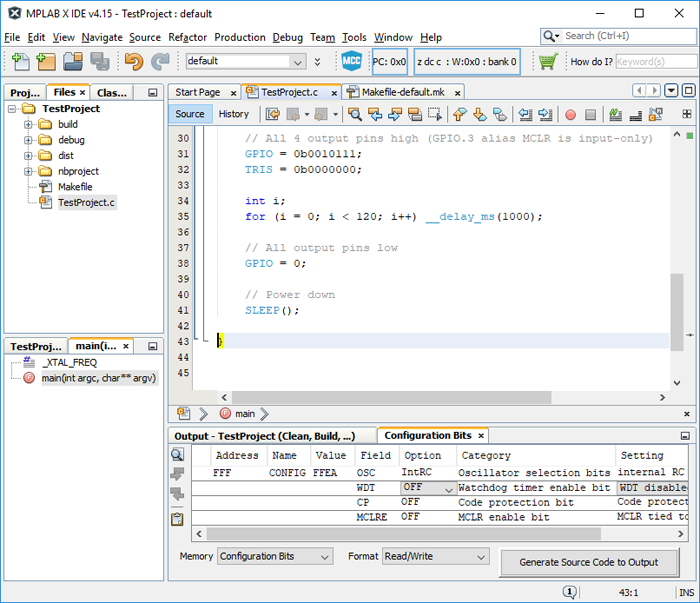
Screenshot of Microchip MPLAB, free development environment for PIC
Up to now, all my dealings with microcontrollers have begun with learning a specific
CPU's assembly language.
I wrote notes about my first experiences with
8051-family,
PIC,
and Atmel AVR microcontrollers.
(The PIC notes in particular are still worth reading.)
I taught 68HC11 and PIC assembly-language programming at UGA in 2005 and 2007.
Learning assembly language was connected with learning the quirky architecture of each
of these tiny CPUs.
The smaller and cheaper, the weirder they got.
Every one of them had strange restrictions on some of the ports and registers,
all of which had to be kept track of.
C compilers were already widely used 20 years ago, but there were two reasons for
the small-scale experimenter (like me) to avoid them.
They were expensive (hundreds of dollars),
and the processors were so tiny that we didn't have a byte to spare;
we didn't want to risk the program taking more space than it had to.
Thousand-dollar optimizing C compilers are still around, but nowadays there are good free ones.
The AVR-based Arduino led the way; I have yet to dive deeply into Arduinos, but they made
microcontroller work easier than ever before, and at the same time, they're cheap and have a
downgrade path — Arduino designs can be converted into standalone microcontrollers that don't
require the Arduino board.
The big advantage of a C compiler is twofold. You don't have to learn assembly language, and you
don't have to keep track of the quirks of the CPU. The compiler knows how many registers there are
and what each one can be used for.
That means a design that might have taken a couple of days can nowadays be finished in an hour.
The disadvantage of a C compiler, especially a non-optimizing one, is that the code occupies more
memory than carefully crafted assembly code.
That is not a problem because CPUs are cheap.
If a program doesn't fit in a smaller chip, you can just move to a bigger one.
The difference is likely to be 50 cents versus 80 cents, rather than $40 versus $150.
We've come a long way.
Going forward, I think one of the mottoes of the microcontroller world needs to be: No job too small.
An 8-pin microcontroller that costs 50 cents doesn't have to be the brain of an electronic device.
It can be an oscillator or level detector. Imagine a phase-locked loop where you can dictate, through
computer code, exactly what it should do when it gets out of sync — you could kick it into a search
algorithm that would have been utterly impossible with analog circuits.
I am actually plotting a circuit where a programmed PIC replaces a single capacitor and is smaller
and cheaper — stay tuned for that.
The other idea I want to toss out is, now that you can buy twenty CPUs for the price of lunch, why does nobody
experiment with massively parallel arrays of tiny CPUs?
Permanent link to this entry


|
2018
March
26
|
Electronic parts and the problem of too many choices
The demise of Radio Shack has changed life for electronics hobbyists and independent
experimenters, and it may be a blessing in disguise.
No longer do we feel pressure to use Radio Shack parts in our projects.
Instead we feel bewilderment from having too many choices!
Thanks to Internet mail order, the entire product lines of large manufacturers are at our fingertips.
How do we know which ones to choose?
I'm trying to reactivate my electronics lab/workshop, where in the 1990s I designed
dozens of construction projects for electronics magazines and a few things for industry.
One thing that is new on the scene is switching MOSFETs (a type of transistor) that turn
on with a control voltage of 2.0 volts or less, and thus can be used in 3-volt battery-powered
circuits. Although I have a large accumulation of parts, I didn't have any of these,
so I decided to order some. So how to proceed?
Dozens of 2-volt MOSFETs are made, with different type numbers, but very
similar in performance.
Which one should I try?
First I looked at Sparkfun
and Adafruit to get a sense
of what's popular with experimenters right now.
I should have remembered one more, Futurlec.
Those are the boutiques that cater to small-scale experimenters.
The third one, Futurlec, has a big selection and really low prices.
But I'm not sure which of their MOSFETs turn on at 2 volts, if any.
[Addendum:] I should add that in between the small boutiques and the really big distributors,
there are two other important suppliers, each with a personality all its own.
All Electronics is a Los Angeles
surplus dealer whose line has expanded to become quite comprehensive.
Jameco is a small distributor whose catalogue
will give you good guidance about what is popular and widely used. Both are
well worth knowing about. You can browse their web sites and catalogues in a way
that you can't do with a distributor.
But I decided to take the high road and deal with one of the major distributors,
Digi-Key (the other big ones are
Mouser, Newark,
and Arrow).
What is important is that none of these has a minimum order any more and
all of them offer very inexpensive shipping of small, lightweight items.
They've caught on that a handful of transistors or ICs doesn't weigh ten pounds
and doesn't need a cardboard box; it can even be airmailed halfway around the world
for a few dollars.
The major distributors offer parametric search, which means I can select from all their MOSFETs
by voltage, package type, and other attributes, then look right at the manufacturer's data sheets.
After a few minutes of doing that, I ended up choosing the
TP2104
from Supertex. Digi-Key's web site shows me that they have it in five flavors:

Two have TO-92 packages (with three wires coming out), and the other three are surface-mount.
Of the two that will do, one is available with a minimum order of 1 (I actually ordered half a dozen)
and costs 61 cents.
How much for shipping and handling? $3.75 for up to 8 ounces of merchandise (I actually ordered
some other things too). And it should get here in about 2 days. Except for the 2-day delay,
that's as convenient as Radio Shack. $3.75 is near the cost of driving to a store.
For a busy consultant, $3.75 may be a lot less than the cost of driving to a store.
What is missing from this picture? I got no guidance as to which 2-volt MOSFETs were
popular or preferred.
Because of the way transistors are manufactured, every maker (except the few that specialize in
perpetuating old types) introduces dozens of very similar products.
Every time the manufacturing process is tweaked, the specifications change a little, and so
does the type number.
I think the TP2104 is one that will remain widely available and
be good to specify in designs in the future. But I don't know. It has many cousins that are
very similar. For all I know, a different one will take over (as the 2N7000 took over the market
at the next voltage level up)
and this one will be left by the wayside. The consequence? If I design and publish
circuits that use this one, and in the meantime a different one catches on, people wanting to build
my circuits will be needlessly inconvenienced.
They may have a good substitute already on hand and not know it.
That is where the limited repertoire
of Radio Shack was helpful; if they carried a part, you could be sure that it had been winnowed out
from many different rivals. That is why I looked at Adafruit and Sparkfun,
but they hadn't settled on one. Sparkfun actually sells some 2-volt MOSFETs in their
discrete transistor assortment, but they are a type that the manufacturer has already marked obsolete.
In The Art of Electronics, Horowitz and Hill use the term "jellybean" for a part that
is so commonly used that you keep a jar of them on your desk (well, not literally).
For example, my "jellybean" op-amp is the TL081; rather than search through hundreds of others,
I use the TL081 unless it
obviously won't do.
My discrete transistors are almost always 2N4401, 2N3904, or 2N3906.
My resistors are 100, 1000, 10k, or 100k ohms unless there's a reason to use something else
(you won't find many 150- or 820-ohm resistors in my designs).
By limiting the choices, we save effort even if we don't save money
(something else might have been a tiny bit cheaper).
Of course, the whole product line is available when needed, but the only way
for a designer to stay sane
is to have a few dozen preferred parts that are used almost all the time.
[Addendum:] Clay Turner writes with a handy hint:
The number in stock at Digi-Key is a good indication of which one is the most popular.
Since they only have two thousand of the transistor I chose, it may be somewhat esoteric.
They have about a million 2N7000's.
Permanent link to this entry


|
2018
March
21
|
The papyrus controversy and Bible translations
This isn't just a science and technology blog. Today I'm going to delve into my
original academic field, ancient languages and historical linguistics.
I am making a long and complicated story short to give you a bird's-eye view
of the issue; there is much more to be known about all of this!
Modern translations of the New Testament are full of footnotes saying that the oldest
and best ancient manuscripts say something slightly different than was traditionally
assumed. Now some scholars think the evidence was weighed incorrectly.
All these translations replace the King James Version (KJV) (Authorized Version) of 1611,
which was the only English-language Bible that most people saw for more than 300 years.
It was translated from early printed editions of
medieval manuscripts of the Greek and Hebrew and was a very good
translation for its time.
The trouble is, it's in old-fashioned English and people can no longer understand it.
A couple of minor revisions were launched in the 1800s but didn't catch on.
Between about 1850 and 1950, archeologists discovered a huge number of New Testament manuscripts
appreciably older than what had traditionally been used. Most were small pieces of papyrus, but
three were book-length (Codex Sinaiticus, Vaticanus, and Alexandrinus).
There was a move to update the traditional medieval (Byzantine) Greek text with information from these
newly discovered older manuscripts.
That led to modern Bible translations, starting with the Revised Standard Version (RSV) in 1946
and continuing with many others (NASB, CSB, ESV, etc.) that fill Christian bookstores today.
The goals of the modern translations are:
(1) To translate into modern English so that words and sentences will not be misunderstood.
(2) To use the newly discovered ancient manuscripts rather than just the later Byzantine ones.
(3) To stick to the sentence structure and wording of the King James Version when no change was
needed, so that familiar passages would remain familiar.
Goal (3) is what "Standard" means in the title of a translation. Some translations abandoned that
goal in order to make smoother English (e.g., the NIV and the REB).
What difference did the newly discovered ancient manuscripts make?
Mostly, they left out words. For example, in
Matthew 5:22,
the Byzantine manuscripts say "angry without a cause" and the papyri just say "angry."
There are minor differences of this sort on almost every page.
(I should add that they very rarely affect the meaning of the sentence.)
And the "snake-handling passage" at the end of Mark is
missing from the most ancient manuscripts.
Some biblical scholars are calling for this issue to be re-thought.
They point out that maybe age isn't everything.
The oldest manuscripts may not be the best. After all, there's a reason why
their version of the text wasn't widely copied and distributed.
Why aren't the Byzantine manuscripts copies of the papyri? Perhaps because the papyri
were not considered to be of such high quality. Maybe they were made hastily for
limited distribution. They argue that it is easier to imagine a hurried scribe
leaving things out than putting things in. And maybe the older copies of the
Byzantine text don't survive because they were heavily used and worn out,
or because they were in a part of the world with a harsher climate.
Maybe the reliance on papyri favored a desert area where papyrus didn't rot,
and the papyri don't tell us what people were using anywhere else.
That's the controversy. I'm not wholeheartedly jumping on the bandwagon, but it's
food for thought. In the meantime, how can the ordinary churchgoer, who is not
trained in archeology, see what all this is about?
Enter the New King James Version (NKJV), a Bible translation that was made by
updating the KJV on a "fix only what's broken" basis. It is in modern English
but sticks close to the KJV's wording (closer than "Standard" translations do).
And it is still translated from the same Hebrew and Greek texts as the KJV.
That means the Byzantine wordings are in the text.
Footnotes tell you about differences in the papyrus-based text (which they call NU)
and in a wider survey of Byzantine manuscripts (which they call MT).
My thought? It's worth looking at, particularly if you do not have other easy
ways of comparing different manuscript groups.
I should add that this is not connected with the "KJV-only" movement.
A few people have gotten it
into their heads that the KJV is Holy Scripture and other translations aren't.
I think that is a mistake that can only be made by people unaware of the non-English-speaking
world. What were Christians in Spain or Germany supposed to be reading, all those years?
But distrust of the papyrus-based text may have been part of the KJV-only group's concern,
and the NKJV addresses that.
Follow-up question: What translation do I use?
Currently, ESV or CSB, but actually, I see very little difference between several "Standard" translations.
Rapid progress is not being made; I think publishers are producing them for market share.
I would caution you against using a translation with a quirky agenda ("inclusive" or something;
I want a translation that tells me what the original says!) or choosing a translation to suit your
own opinions. I wrote more about this a while back.
One more thing. Good modern English is not necessarily "easy English."
Part of the Bible are complex and subtle.
I don't ask for it to be "dumbed down."
There is a place for beginning readers' Bibles, but you have to accept that
you're giving up something.
Permanent link to this entry


|
2018
March
20
|
What is an honest technician?
I've been browsing through old electronics magazines
similar to the ones from which I got my first knowledge of electronics, back in the last century.
Circa 1960, television sets were very unreliable; they were full of tubes with inherently short lifespans and
other components that had short lives because they operated their their limits of power and temperature.
A common complaint was that repair shops "gypped" the customers by performing unnecessary repairs.
Sometimes, no doubt, they did. But quite a few of the people caught red-handed weren't really
red-handed.
A typical trick was for an investigative reporter to rig a TV set by putting in a blown fuse or
some other defective but easily replaceable part (not a tube, that would be too easy) and
taking it to a repair shop.
They would then complain bitterly that the blown fuse wasn't the only thing replaced.
In their defense, the technicians pointed out two things, which I think still apply to modern
technology:
(1) A fuse or resistor doesn't burn out by itself. It is reasonable to assume that it was taken
out by some other, more failure-prone part in the same circuit, which may have shorted only
momentarily. That's a good reason to replace a tube or capacitor that is under suspicion.
The investigative reporter's "rigged" TV was rigged to fool the technician and it's no
surprise if the technician fixes what seems to have happened rather than what did happen.
(2) Most people want their TV to come out of the shop reliable, not just temporarily fixed.
Accordingly, a good technician looks for other parts that are nearing end of life, especially tubes,
and replaces them all at the same time.
I think the same principles apply to lots of kinds of repair today, including auto repair.
There's a balance between "just fix what's broken" and "make it last forever." Sometimes a part that
is starting to go out of spec will continue to work well for years. That's particularly the case
if the design of the surrounding circuit is very conservative. (There are jokes about military-grade
equipment that still works with half the parts taken out — an exaggeration, of course, but it's
remarkable how much deterioration some equipment can tolerate.)
And technicians who do repairs proactively are not cheating, though you may disagree about their
priorities. In that situation it's good to communicate with the technician or auto mechanic about how
much of a preventive approach you're willing to pay for.
Permanent link to this entry


|
2018
March
16
|
NGC 2343 and surrounding nebulosity

The star cluster NGC 2343 (center) is adjacent to a large emission nebula
known as the Seagull Nebula, which looks a bit like a bird flying out of the picture toward
the right. This stack of five 3-minute exposures was made while testing the
autoguiding software described below. Canon 60Da, AT65EDQ 6.5-cm f/6.5 apo refractor,
Celestron AVX mount, guidescope and autoguider.
Permanent link to this entry
Autoguiding under Linux achieved
Because of Windows updates that have temporarily disrupted video functionality in the past,
I've been putting together a non-Microsoft alternative for astronomical imaging and autoguiding.
Here I do not give complete instructions because I'm still experimenting, but I'll sketch
what I've learned.
See also the discussion here.
(1) Instead of ASCOM, Linux uses INDI drivers.
You will also need INDI Starter, an interactive program to start the
drivers and make settings, although some application software can use the INDI drivers without it.
You will need to set up drivers for your camera and your mount.
Here is INDI Starter in action:
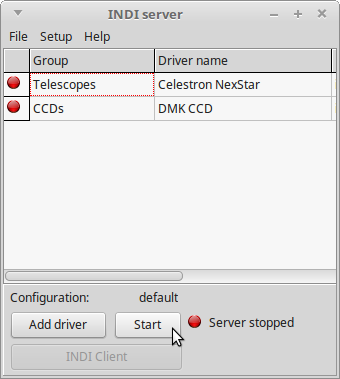
Settings are under "INDI Client" at the bottom, and you can make them after
starting the server, before connecting to the devices.
Connecting to the devices will be done in PHD2.
I am told that a good alternative is to download and install
KStars, a planetarium program
that includes camera control, a full INDI setup, and controls for launching INDI.
I have not (yet) taken that route.
(2) The goal is obviously to use the
Linux version of PHD2 Guiding,
maintained by Patrick Chevalley, whom I thank for his help.
(3) If you have an ASI120MM camera, you have it easy because PHD2 supports it natively.
I, however, am using an early model DMK camera from The Imaging Source.
It is basically a webcam and operates through the V4L2 (Video for Linux) driver system.
That's where my story got interesting.
(4) To acquire V4L2 drivers, the easiest way to proceed is to
acquire and set up oaCapture,
which I wrote about recently.
Get it working before proceeding with PHD2.
And never mind my quibbles about video codecs; if you can record video and
play it back under Linux, you have everything you need.
Presumably, setting up KStars with the same camera would do just as well.
(5) For my camera to work with PHD2 Guiding, I had to tell it that the camera does not support
long exposures (with its INDI driver; it does under Windows) and make other settings as follows:
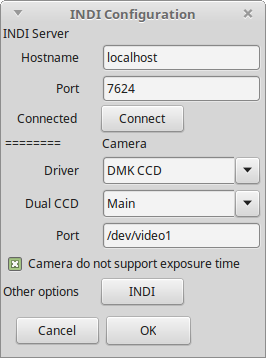
(This window is in PHD2. There is a button on it that opens the settings windows
that belong to INDI.)
On my computer, /dev/video1 is the external camera; /dev/video0 is the one built into the computer,
and I was quite startled to see my own face when I was trying to capture a star image!
And here's the result: success! PHD2 works much the same way as under Windows. The only important UI difference
I noticed is that I had to tell PHD2 to display each of the sub-windows one by one, under View;
initially it displayed only the captured image.

Permanent link to this entry


|
2018
March
8
|
Against twice-yearly clock changes
Florida has just voted to stop changing its clocks twice yearly and move to year-round
Daylight Saving Time instead. At their latitude, this makes a certain amount of sense,
though I would have preferred year-round Standard Time, as is already the practice in
Arizona and Hawaii.
Meanwhile, Massachusetts is agitating to move to year-round Daylight Saving Time (or, as
they phrase it, move from Eastern Standard Time to year-round Atlantic Standard Time —
same thing), and if they do, Maine and New Hampshire want to join them.
I've written about this many times before. My key points:
- Changing the clocks twice a year is quite a chore now that every house has ten or
twenty clocks in it. We're not talking about one big grandfather clock that needs to be set
every week anyhow.
- The change every spring costs lives. People lose sleep and have car crashes.
This is well established.
- There is no real difference in energy consumption between standard time and DST.
One or the other of them was supposed to "save energy" but doesn't.
-
There is no longer strong pressure to keep everything in sync with one of the big north-south railroads.
Airlines are accustomed to dealing with different time zones.
They'd have it easier if every place stayed in the same zone, whatever it might be, all year.
-
If children are having to go to school before dawn, that may be the concern of the schools,
not the sun. It doesn't make a lot of sense to choose inconvenient times for things and then complain
that the sun is rising too late.
- The days are longer in the summer and shorter in the winter by nature, regardless of what
we do to the clocks. We need to keep mentioning this because I've run into people who aren't
fully aware of it. About two thirds of the lengthening of summer evenings would be there even
without DST.
I would prefer year-round standard time, but year-round DST is about equally convenient, or even a
compromise between the two (add half an hour to standard time); just choose one and
stop making us switch twice a year!
Permanent link to this entry
Short notes
Not only fake news, but fake history:
There is a story going around about how the American Revolution started over a gun confiscation
incident on April 20, 1775. It didn't, and there was no such incident.
The story was supposedly "satire" but I maintain that it's not satire if it's not humorous.
Spreading plain misinformation and calling it "satire" is a tiresome tactic.
(More about this is in Snopes.)
Is an unattended, loaded gun dangerous?
A graduate student at the IAI found one at a campus bus stop and called the police last Saturday night.
I know of no further developments, but in online conversation today I described this as a
"disconcerting incident" and was asked (presumably with a straight face) why it's disconcerting.
If you have to ask, you're never going to know.
Permanent link to this entry


|
2018
March
6-7
|
Orion as I first saw it
To anyone wanting to learn the constellations, I recommend starting out
in twilight, before the sky is completely dark.
At that time there aren't so many stars to confuse you, and the
brightest ones stand out.
Here is what I saw in the sky fifty years ago this month:

In March, 1968, during twilight on
several consecutive days, a group of three stars in a row caught my eye.
They were the belt of Orion, the first part of any constellation that I had
ever successfully recognized. Of course, Orion is the key to several others,
so I quickly matched up the rest of the sky with the maps I had.
(My recollection is that I had a planisphere, and Sam Brown's All About Telescopes,
and some books out of the library, but not yet a star atlas. I got Norton's later
that year.)
The picture shows Orion in twilight, as I photographed it this evening (March 7).
The view that I recall from 1968 matches how the sky looked with the sun 10 degrees
below the horizon, but the photographs that best capture the view were taken a bit
earlier, with the sun higher. This was
a two-second exposure, Canon 40D at ISO 400, Canon 28/2.8
lens at f/5.6.
My first reaction to recognizing Orion in 1968 had also been to try to photograph it,
but with no tripod to hold the camera steady, I was unsuccessful.
Permanent link to this entry


|
2018
March
3-5
|
An uncatalogued nebula in Monoceros

Let me offer this to you as an observing challenge.
The nebula just above center here is an object I've written about before.
It is the visual counterpart of the a radio source listed in SIMBAD as GAL201.6+01.6
(which is just a positional designation).
As far as I know the visible object is not catalogued at all.
It is probably comparable to a 12th to 14th-magnitude galaxy in visibility,
but I haven't tried to see it, only photograph it.
The star cluster at the upper left is NGC 2259. Then there's the 6th-magnitude star SAO 95914, and then the nebula.
I am working on getting better photographs of this object. This one was taken
in town with an AT65EDQ 6.5-cm refractor, Canon 60Da, and Astronomik CLS filter.
Stack of eleven 3-minute exposures.
Even so, I seem to have gotten more in my photograph than the Digitized Sky Survey did.
Has the object brightened over the years, I wonder?
Permanent link to this entry


|
2018
March
2
|
The big thing wrong with computer security
In Computing Edge for February 2017 (yes, I'm that far behind reading magazines),
Bruce Schneier of Harvard has an opinion piece whose title says it all:
Stop Trying to Fix the User.
If you step back and look at it from a distance, computer security is a strange business
because ordinary people are burdened with so many strange responsibilities.
Memorize a hundred passwords and never write them down.
Don't click on links in e-mail.
Don't open files that are sent to you.
And so on.
No other machine is dangerous to use in ways that seem totally normal.
Unique about networked computers is the fact that
if you use the technology the way it's obviously meant to work
(such as clicking on a link), you put yourself in danger.
The human user bears a great burden of
remembering not to use the machine the way the machine wants to be used
until additional checks have been made.
This is almost the only area of human activity where we
have to caution people not to follow instructions.
Why is all this the case? Because the Internet was invented in research labs,
where everyone was trustworthy and no one believed in universal human sinfulness.
This naïveté persisted and became entrenched in computer culture.
Networked computing as we know it today seems to be designed to be dangerous.
And new dangers were added long after it left the research labs —
look at the mischief that came from somebody's bright idea of letting
web browsers run software supplied by the web site (ActiveX).
How to fix it? No single change will solve the problem, but the biggest thing we need
to do is acknowledge how far we are from the ideal.
Networked computing as it exists today
is deeply wrongheaded in more ways than we immediately recognize.
Deep changes will be needed to make it safer.
Good virus-proofing may require going all the way down to CPU architecture.
Plastering minor layers of protection onto wrongheaded systems
is not the solution, although under present conditions we can't do without it.
Permanent link to this entry


|
2018
March
1
|
Where is hobby electronics heading?
[Updates in blue type.]
The slight lull in activity has given me time to look at some other interests, and I get a strange
feeling about a trend in hobby electronics.
Make has a Morse-code communication device that uses the Internet, and
Nuts & Volts has an extremely elaborate analog-face clock made out of LEDs.
Somehow, neither of these has the appeal of thousands of hobby projects I've read about
(or dozens I've authored) since I started reading electronics magazines more than 50 years ago.
They strike me as hard ways to do easy things. For Morse code, you don't need two
Raspberry Pi computers, even if they're cheap. All you need is a key, a buzzer, a battery,
and some wire (or, for communication, two keys and two buzzers).
As for an analog clock face...
I'm not saying there's anything wrong with these projects, only that they don't
appeal to me; they cause a vague sense of unease.
And I think I have a name for the unease: faux retro.
I like genuine "retro" technology, using and keeping alive the technology of the past.
I like genuinely new, modern technology.
I even like useful combinations of the two, such as digital current meters on a tube guitar amplifier,
or red LED safelights in a traditional darkroom. (They're nearly monochromatic and are the best
safelights we ever had!)
What leaves me uneasy is superficial imitation of old technology using new.
You end up with a worst of both worlds situation.
When a digital camera simulates grainy film, not only is the result unappealing, it does not
exploit any advantage of either digital photography or film.
When you send Morse code by Internet, you have neither the simplicity of the telegraph
nor the power of the Internet.
[Update:] Digging deeper I see that it was a coincidence that I saw two "faux retro" projects
in succession and overestimated their commonness.
There is much healthy creativity in hobby electronics nowadays.
I'm surprised to learn that for $5 I can buy a microcontroller board that will
put all my software skills to the test — such things run Linux and can run
any kind of software I know how to develop.
But for security reasons I'm inclined to stick with Arduino, without WiFi,
for simple things.
I'd rather not run Linux (which outsiders might hack) if a single hard-coded program
will do the job.
Where should hobby electronics be going?
That's what I need to think about.
A lot of the things we used to do, such as listening to foreign radio broadcasts,
are now excessively easy due to the Internet; no gadgetry is needed.
More importantly, modern manufacturing has made it easier to buy things whole
than build them, such as video door intercoms, high-precision clocks, and so forth.
What should electronics enthusiasts and project authors be looking at these days?
I'm not sure, but here are some vague ideas.
- Interfacing to useful but unusual devices. Why can't my computer know how long my
washing machine has been running, and signal me when it stops?
- Environmental sensing. Has today's mail been delivered? Is there lightning in the area?
- Simple solutions to out-of-the-way power problems. We all need to know more about lithium
batteries. For that matter, lead-acid isn't dead... For several years I've been meaning to
design and build an amp-hour battery capacity tester.
- Making software a first-class citizen. For thirty years, too many "electronics" projects have
involved secret software, something magical that you download that makes it work.
Now that almost everything electronic has software in it, let's talk and write about for-loops,
not just op-amps. (Python helps; for the first time in a while, we can write useful programs that
are short enough for people to read.)
- No job too simple. For example, I want to devise a simple, low-power way to make an
LED come on at the touch of a button, and then go off about 2 minutes later. This is very useful for
things like illuminated eyepiece reticles, and with a big white LED, could be useful in any closet.
The trick is to keep it tiny and low-power, and make sure it's really "off" when it's off.
That last one brings up another theme: Any fool can do it with a microprocessor, but I can
do it with a handful of cheap, discrete components (I think!). I'm thinking of a Darlington pair
with a resistor added to prevent leakage... The challenge is to have the "off" current be extremely low
(well under 1 microamp) so that the battery doesn't run down.
The point is, control and decision-making don't necessarily require digital circuitry.
That kind of thing excites me. Faux retro gadgeteering doesn't, but to each their own.
One other thing. The projects I have most enjoyed designing, or building, or reading about
always involved a concept, some kind of key insight or interesting thing to learn.
Satisfying projects are not just assemblies of lots of little things piled together
to make a big whole.
[Further note:] Back in the 1990s I gave a talk about the future of hobby electronics.
I predicted at the time that modification would come to outweigh building equipment
from scratch. Buy something close to what you want, then adapt it.
I also predicted a greater role for breakout boards, which contain an IC together
with the necessary or common support components. There was a wave of consumer-electronics ICs
that all seemed to require 20 capacitors externally. Fortunately, those seem to have gone away.
But an excellent example of a breakout board is Adafruit's FTDI Friend,
which is a USB-to-serial adapter. (Yes, I know USB is serial; I mean old-fashioned serial,
RS-232 but at logic levels.)
Unduly attentive readers will note that the type on this page has gotten a bit smaller again.
I'm still experimenting... This isn't a magazine, and I don't have to keep the format the same
every month.
Permanent link to this entry


|
|
|
This is a private web page,
not hosted or sponsored by the University of Georgia.
Copyright 2018 Michael A. Covington.
Caching by search engines is permitted.
To go to the latest entry every day, bookmark
http://www.covingtoninnovations.com/michael/blog/Default.asp
and if you get the previous month, tell your browser to refresh.
Portrait at top of page by Krystina Francis.
Entries are most often uploaded around 0000 UT on the date given, which is the previous
evening in the United States. When I'm busy, entries are generally shorter and are
uploaded as much as a whole day in advance.
Minor corrections are often uploaded the following day. If you see a minor error,
please look again a day later to see if it has been corrected.
In compliance with U.S. FTC guidelines,
I am glad to point out that unless explicitly
indicated, I do not receive substantial payments, free merchandise, or other remuneration
for reviewing or mentioning products on this web site.
Any remuneration valued at more than about $10 will always be mentioned here,
and in any case my writing about products and dealers is always truthful.
Reviewed
products are usually things I purchased for my own use, or occasionally items
lent to me briefly by manufacturers and described as such.
I am an Amazon Associate, and almost all of my links to Amazon.com pay me a commission
if you make a purchase. This of course does not determine which items I recommend, since
I can get a commission on anything they sell.
|
|

















